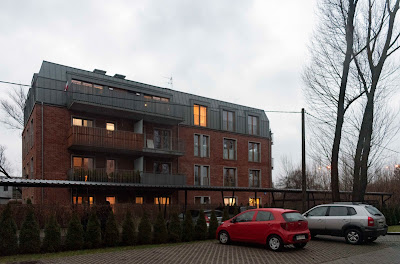Below: the bottom end of ul. Kujawiaka, where it meets ul. Jeziorki. This muddy track, maybe three metres wide, is a proper Warsaw street; the sign informs taxi drivers where Zone 2 begins, the Warsaw equivalent of "double-time on the metre, guv." What taxi driver would like to venture down here?
Ul. Kujawiaka was once called ul. Poloneza. Since the S2 cut a line across the Jeziorki-Grabów border, the lower part of it (1.5km) south of ul. Krasnowolska, has been renamed, up to and including the viaduct that crosses the S2 and the Metro's rail link to the outside world. From the narrow muddy path, above, to a four-lane road in a few hundred metres. The northern end, north of ul. Krasnowolska, retains the Poloneza name.
Below: 400m separates a muddy path to a four-lane viaduct - the same road. Ul. Kujawiaka, looking towards its northern end, where it joins ul. Krasnowolska.
Below: Krasnowola bus loop - end of the line, by a decorated wayside chapel. This is where the 239 terminates, a weekdays-only local line linking Grabów with the metro. The bus stop is numbered 51, the '5' prefix suggests a temporary location. When the 239 was inaugurated in January 2018, WTP stated that this would be the case, with the intention of finally locating a permanent bus loop some half a kilometre further west (ul. Tramblanki). With the S2 tunnel now open and the S7 extension nearing completion, perhaps WTP will get round to finalising this route...
Below: repurposed brick - ul. Poloneza, south of ul. Krasnowolska. The building (also visible in the photo above) was built during WW2 by the German occupiers to house force labour. In the late 1990s/early years of this century, it was used as a dziupla ('hidey-hole') for car thieves, who'd bring stolen cars here to be dismantled for parts. Since then, it has been converted into trendy apartments!
Below: the 160-year old Willa Krasnowola - I wrote about this crumbling ruin nearly 14 years ago (June 2008); it's still there - neither demolished, nor repurposed - just standin' over there, decaying.
Below: looking along the unelectrified coal-train line to Okęcie sidings. To the left, the lights of the S79 expressway, set low under the flightpath to Runway 33 of Warsaw Okęcie airport. The twin-track electrified mainline is to the left of the entirely separate single-track coal-train line.
Below: the Metro rail link, looking towards the lights of Mordor (Służewiec Przemysłowy as was, now one of Warsaw's main office districts).
Below: the Metro rail link looking towards Ursynów and the curved bridge carrying it over the S2. From here, across ul. Puławska and into the Las Kabacki forest, the line runs parallel to the expressway.
Below: ul. Hołubcowa, south of the viaduct. Another one of Warsaw's roads that runs out of asphalt and carries on to its end in the form of a muddy track meandering through fields - a track capable of swallowing cars (even 4x4s) up to their axles in thick goo.
Below: ul. Sztajerki, caught in the crook of two expressways a main railway line and international airport. Otherwise, a quiet backwater of Warsaw, around 7 miles from the city centre. Like so many streets in Zielony Ursynów ('green Ursynów') west of ul. Puławska, from Poleczki in the north to Sarabandy in the south, are named after dances. A 'sztajerek' is a folk-dance related the Ländler, being a dance in 3/4 time once popular in Austria, Bavaria, German Switzerland, and Slovenia.
Left: looking towards the top end of ul. Kujawiaka. In the foreground a small pond - the land here is poorly drained. Although there's a fair amount of traffic turning onto Kujawiaka from ul. Ludwinowska, there's little traffic continuing along Ludwinowska heading for ul. Sztajerka. Note the luminous green orb by the tree in the foreground - an internal reflection within the lens of the streetlight diagonally opposite it in the frame.
Left: ul. Kujawiaka again, this time heading back down south towards ul. Jeziorki. An airliner is on final approach to touchdown at the airport.
Miserable but warm weather (10C) and cloudy; not the stuff of flashbacks, blue skies, sparkling snow and a crisp frost. A different atmosphere altogether. Maybe flashbacks for another time, and another place.
This time four years ago:
1929-1939; 2008-2018?
1929-1939; 2008-2018?
This time six years ago:
Track works between W-wa Okęcie and W-wa Dawidy
This time eight years ago:
The benefits of extending the human lifespan
This time 11 years ago:
New Year's stocktaking
This time last 12 years ago:
A walk in the wild winter woods
This time 13 years ago:
Now that's what I call winter vol. 12
This time 14 years ago:
When the day starts getting longer
Track works between W-wa Okęcie and W-wa Dawidy
This time eight years ago:
The benefits of extending the human lifespan
This time 11 years ago:
New Year's stocktaking
This time last 12 years ago:
A walk in the wild winter woods
This time 13 years ago:
Now that's what I call winter vol. 12
This time 14 years ago:
When the day starts getting longer



















No comments:
Post a Comment